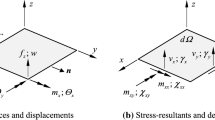We propose a computational model of plane compact wedge-shaped specimens with stability regions of the stress intensity factor at the tip of an edge crack whose length increases. This model is used for the determination of the crack resistance of materials with regard for the influence of various operating factors. On the basis of the method of singular integral equations, we obtain the numerical solutions of model problems for wedge-shaped specimens subjected to uniaxial eccentric tension. We reveal the influence of the modes of loading of these specimens and their geometric parameters on the behavior of the stress intensity factor depending on the crack length and establish the ranges of the geometric parameters guaranteeing the presence of maximum stability regions for the stress intensity factor in the process of quasistatic crack growth.






Similar content being viewed by others
References
V. V. Panasyuk (editor), Methods and Means for the Evaluation the Crack-Growth Resistance of Structural Materials. A Collection of Scientific Works [in Russian], Naukova Dumka, Kiev (1981).
V. V. Panasyuk and S. Ya. Yarema, Problems of Strength, Durability, and Reliability of the Products of Machine Building. Methodical Recommendations. (Developed by the Karpenko Physicomechanical Institute, Ukrainian National Academy of Sciences) [in Russian], “Nadezhnost’ Mashin” Interdepartmental Scientific-and-Engineering Complex, Moscow (1993).
S. Mostovoy, P. B. Crosley, and E. J. Ripling, “Use of crack-line loaded specimens for measuring plane-strain fracture toughness,” J. Mater., 2, No. 3, 661–681 (1967).
V. V. Panasyuk (editor), Fracture Mechanics and Strength of Materials: A Handbook, Vol. 4: О. N. Romaniv, S. Ya. Yarema, G. N. Nikiforchin, N. A. Makhutov, and M. M. Stadnik, Fatigue and Cyclic Crack-Growth Resistance of Structural Materials [in Russian], Naukova Dumka, Kiev (1990).
О. P. Ostash, V. М. Fedirko, V. M. Uchanin, S. A. Bychkov, O. H. Molyar, О. І. Semenets,’ V. S. Kravets,’ and V. Ya. Derecha, “Strength and durability of aviation materials and structural elements,” in: V. V. Panasyuk (editor), Fracture Mechanics and Strength of Materials: A Handbook [in Ukrainian], Vol. 9, Spolom, Lviv (2007).
J. E. Srawley and B. Gross, “Stress intensity factors for crackline-loaded edge-crack specimens,” Mater. Res. Stand., 7, No. 4, 155–162 (1967).
W. Beres, A. K. Koul, and R. Thambraj, “A. tapered double-cantilever-beam specimen designed for constant-K testing at elevated temperatures,” J. Test. Eval., 25, 536–542 (1997).
E. N. Brown, N. R. Sottos, and S. R. White, “Fracture testing of a self-healing polymer composite,” Exp. Mech., 42, 372–379 (2002).
E. N. Brown, “Use of the tapered double-cantilever beam geometry for fracture toughness measurements and its application to the quantification of self-healing,” J. Strain Anal. Eng. Des., 46, 167–186 (2011).
C.-J. Li, W.-Z. Wang, and Y. He, “Measurement of fracture toughness of plasma-sprayed Al2O3 coatings using a tapered double cantilever beam method,” J. Amer. Ceram. Soc., 86, No. 8, 1437–1439 (2003).
M. P. Savruk, P. N. Osiv, and I. V. Prokopchuk, Numerical Analysis in Plane Problems of the Theory of Cracks [in Russian], Naukova Dumka, Kiev (1989).
M. P. Savruk and A. Kazberuk, “Stress concentration in solids with notches,” in: V. V. Panasyuk (editor), Fracture Mechanics and Strength of Materials: A Handbook [in Ukrainian], Vol. 14, Spolom, Lviv (2012).
M. P. Savruk and V. S. Kravets', “Application of the method of singular integral equations to the determination of the contours of equistrong holes in plates,” Fiz.-Khim. Mekh. Mater., 38, No. 1, 31–40 (2002); English translation: Mater. Sci., 38, No. 1, 34–46 (2002).
M. P. Savruk, “Stress intensity factors in bodies with cracks,” in: V. V. Panasyuk (editor), Fracture Mechanics and Strength of Materials: Handbook [in Russian], Vol. 2, Naukova Dumka, Kiev (1988).
V. V. Panasyuk, M. P. Savruk, and A. P. Datsyshyn, Distribution of Stresses Near Cracks in Plates and Shells [in Russian], Naukova Dumka, Kiev (1976).
V. V. Panasyuk, M. P. Savruk, А. I. Zboromirskii, O. P. Ostash, and Е. М. Kostyk, “Specimen for the investigation of the regularities of crack initiation,” Fiz.-Khim. Mekh. Mater., 20, No. 4, 66–77 (1984).
Y. Murakami, Stress Intensity Factors. Handbook, Vol. 1, Pergamon Press, New York (1987).
R. D. Gregory, “A circular disc containing a radial edge crack opened by a constant internal pressure,” Math. Proc. Cambridge Phil. Soc., 81, No. 3, 497–521 (1977).
S. Ya. Yarema, Test Method for Determination of Crack-Growth Rate and Crack Extension Resistance under Cyclic Loading [in Ukrainian], Karpenko Physicomechanical Institute, Ukrainian National Academy of Sciences, Lviv (1994).
О. L. Bowie, “Solutions of plane crack problems by mapping technique,” in: Methods of Analysis and Solutions of Crack Problems, Noordhoff, Leyden (1973), pp. 1–55.
W. P. Brown, Jr. and J. E. Srawley, Plane-Strain Fracture Toughness Testing of High-Strength Metallic Materials, ASTM, National Aeronautics and Space Administration, Philadelphia (1966).
M. Isida, R. Imai, and H. Tsuru, “Symmetric plane problems of arbitrarily shaped plates with an edge crack,” Trans. Jap. Soc. Mech. Eng., 45(395A), 743–749 (1979).
J. E. Srawley and B. Gross, “Stress intensity factors for bend and compact specimens,” Eng. Fract. Mech., 4, No. 3, 587–589 (1972).
X. H. Liu and F. Erdogan, “An elastic strip with multiple cracks and applications to tapered specimens,” Int. J. Fract., 29, No. 2, 59–72. (1985).
Author information
Authors and Affiliations
Corresponding author
Additional information
Translated from Fizyko-Khimichna Mekhanika Materialiv, Vol. 53, No. 5, pp. 31–41, September–October, 2017.
Rights and permissions
About this article
Cite this article
Kravets’, V.S. Stressed State of a Plane Wedge-Shaped Specimen with Edge Crack Under Uniaxial Tension. Mater Sci 53, 609–622 (2018). https://doi.org/10.1007/s11003-018-0115-1
Received:
Published:
Issue Date:
DOI: https://doi.org/10.1007/s11003-018-0115-1




